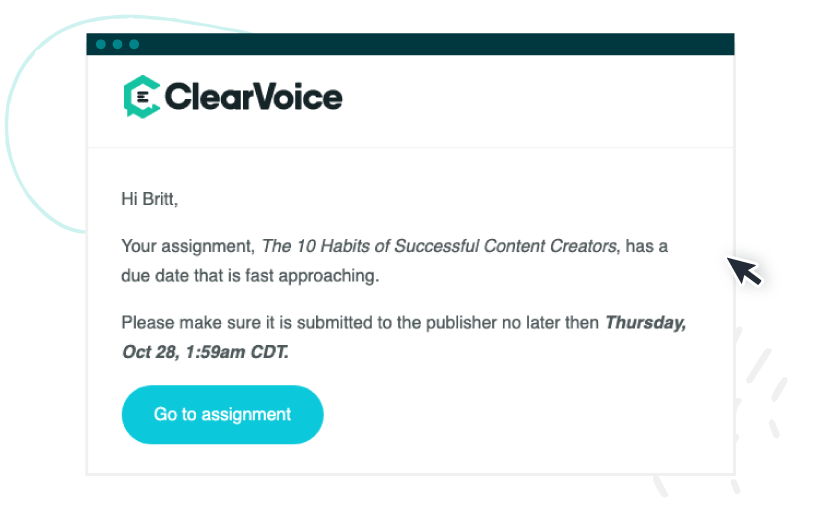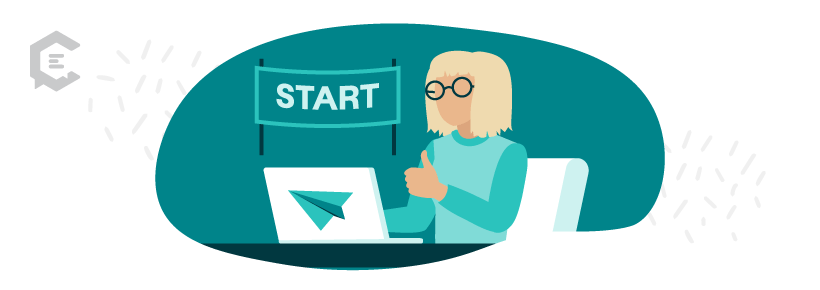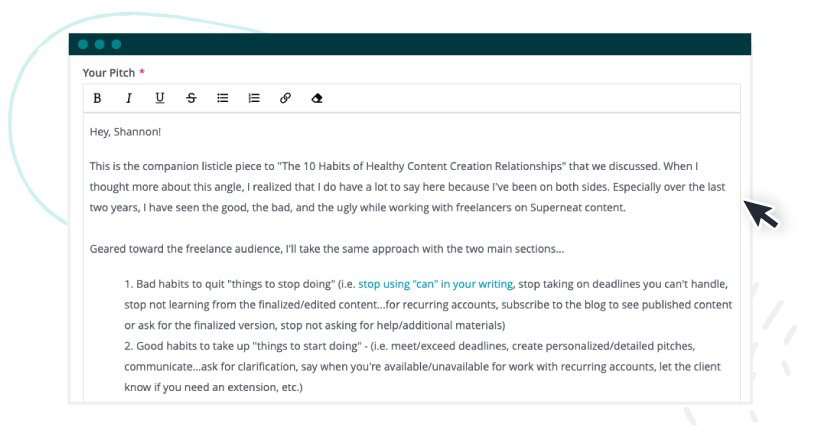There are a lot of content creators out there, but all are not created equal. There are those who have a full book of work and they love the work they do. There are others who are perpetually looking for work and taking on work they don’t actually enjoy.
Once upon a time, I was a freelance content creator. Five years later, I run my own content marketing firm where I regularly hire and work with writers. I’ve been on both sides of content creation and I’ve seen the good, the bad, and the ugly. Along the way, I learned what it takes to reach success as a content creator.
These are the bad habits to quit and the good habits to adopt if you’re ready to step up your content game.

Things to stop doing as a content creator
Bad habits happen to good people. Be on the lookout for these common content creator missteps so you can be the best version of yourself and produce your best work.
1. Stop taking on deadlines you can’t handle.
Life gets in the way sometimes — you get sick, you have a family emergency, you don’t have internet. These are all legitimate reasons to miss a deadline. Then there are other times when you overcommit to a workload you simply can’t keep up with. A domino effect happens and you fall behind on one content assignment after another.
Time management and project management are both extremely important for content creators. If you’re overloaded, don’t say “yes” to work you don’t have time for. Quality content is a must for any brand you work with. The last thing your client wants is a piece that has been slapped together and causes grammar headaches.
A lot of writers get into trouble with deadlines when they wait until the final hour to start working on a content assignment. You might realize you’re missing materials you need or that you need clarification on something, but it’s too late. Work ahead of your deadline so you don’t feel rushed, overwhelmed, stressed… set up for a missed deadline and/or low-quality content.
2. Stop pretending that “you’ve got this.”
If you don’t fully understand a content assignment, don’t just power through and pretend that you do. There is no way to “fake it until you make it” with content. When content is fudged together, your client can tell. This may require painful rounds of revisions and possibly end the content creation relationship you painstakingly built with this client.
Your client may have rushed through the instructions or they may have given you a topic that goes right over your head. Speak up. Ask for help — maybe that’s a quick question or something more involved like needing extra support materials or a phone call. Or, turn it down — be upfront and say that you’re not the right fit for that assignment.
3. Stop accepting the work you don’t want.
Piggybacking off the last point in #2 about turning down work, let’s have a heart-to-heart about this for a sec. Yes, it’s difficult to say “no” to work, whether you are a part-time or full-time content creator. But, there are times when you definitely should walk away.
Nobody should have to suffer through content creation… that includes you and your client. If you’re writing about something you don’t know or don’t love, it will show in your work. When you stop accepting the work you don’t want, it frees up your time for the work you do want. Time is time. Make sure you’re spending it thriving instead of suffering.
4. Stop overusing “can” in your writing.
“Can” is a stealth word that has infiltrated our content. Don’t believe me? The next time you finish a draft, search your document to see how many times you overused the word “can.” When I’m editing content, I often see “can” 20+ times in a 1,000-word piece when there should be no more than 5 “can’s” in a piece of that length.
“Can” is a filter word that you need to filter out. “Can” is an extra word that weakens your writing and distracts the reader. Commonly discussed in fiction writing circles, overusing filter words should be avoided in content marketing as well for obvious reasons as you don’t want to sacrifice the impact of your messaging.
To improve your writing, as a final editing sweep, challenge yourself to remove and/or replace the word “can” if you catch an excessive amount of these filter words.
Here are a couple of examples…
- With can: How Synchronized Care Delivery Can Impact Patient Outcomes
- Remove can: How Synchronized Care Delivery Impacts Patient Outcomes
- With can: When real-time data can be pulled into a report with a simple query, leadership teams can see the entire picture and make more informed decisions.
- Remove and replace can: When real-time data is pulled into a report with a simple query, leadership teams see the entire picture and make more informed decisions.
5. Stop skipping a review of the finalized content.
The draft you submit to your client will likely not be the final draft. One of the best ways to improve as a content creator is to learn from the finalized version of your content. This is especially important for long-term accounts you write for as it will make your life and your client’s life that much easier.
Blog content is easy to stay on top of — just subscribe to their company blog and review the published piece you wrote.
For other types of content (i.e. website content, marketing assets), ask your client if they’ll share the finalized link or draft so you can learn from their changes and suggestions. Your client should not see this as a strange ask as they should be happy to hear that you want to keep making content improvements.
Things to start doing as a content creator
Now that you’ve ditched those bad habits, it’s time to make room for even more progress by taking up these good habits practiced by successful content creators.
1. Start exceeding expectations.
Meeting versus exceeding expectations is the difference between content creators who get hired sometimes and all the time. Meeting expectations is the bare minimum while exceeding expectations is going the extra mile.
If you’re looking for a sure-fire way to exceed expectations, always aim to overdeliver. The over-delivery method that warms my heart is when a writer delivers before the deadline. Getting content early is very much appreciated.
I always go back to writers who not only “meet” their deadlines but “exceed” them. On the other hand, I do not work with writers who have a habit of missing deadlines — specifically, if they do not communicate with me or do it frequently.
2. Start creating competitive pitches.
To stand out in a sea of pitches, you need to maintain a competitive mindset. Every pitch is a business opportunity, so treat it as such. The goal is to offer a pitch they can’t refuse, so create pitches by including the following in a concise little package…
- Share real-world experiences: This demonstrates why you’re the right writer for the job. You’ve lived through something and you have value to offer someone else through your words.
- Give important details: This lets the client know that you’ve given this some thought and it’s not some random idea. Some semblance of an outline is always a good move, as is providing inspiration links.
- Offer a few extras: This adds more substance and value to your pitch. Will you provide keyword research? Help cross-promote? Include graphic ideas? Put a little extra icing on the cake to make your pitch irresistible.
- Personalize the pitch: This shows you’re human and you’re acknowledging your client is also one. Say “hi” and use their name. Express your gratitude for the opportunity.
3. Start building relationships with the clients you love.
It isn’t every day that you find a client that is a joy to work with. You enjoy creating content for their brand and they set you up for success every time… these things don’t just happen. Hang onto these clients by building relationships that are built to last.
You’ll be on your way to building strong client relationships if you avoid the bad habits previously discussed and adopt the good habits in this section you’re reading now. So, keep going…
4. Start communicating more proactively.
Why wait for your client to come to you with work? If you’re available, reach out to them and see if they have work for you. I have a couple of writers that do this from time to time and I give them work pretty much on the spot.
Your clients are busy, so be more proactive with communication. This practice applies to your availability in general (i.e. letting your long-term client know when you’ll be out for two weeks). But, it also applies to those times when you need more clarification or an extension.
5. Start being yourself, and also… be cool.
I’ve worked with a lot of different writers over the years. I often find that I end up working with certain writers long-term because they have a strong sense of self and they’re easy to work with.
They get things done, but they also care. They revise without pushback and they accept whatever complex topic I throw at them. They always submit on time and alert me when they can’t. They say friendly things like “hello,” “thanks,” and “hope you’re having a great week” instead of just submitting drafts without saying a word.
Showing a little personality and friendliness goes a long way during the content creation process. We’re all just people working together at the end of the day.
Two words to live by as a content creator trying to make it out there in the world…
- Overcommunicate
- Overdeliver
Your job is SO much more than writing. It’s a multi-faceted role where you need to be a go-getter and a collaborator. If you practice these healthy habits and leave the unhealthy habits behind, you’ll reach success along the way.






